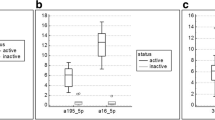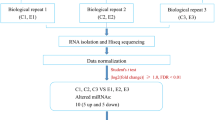Abstract
MicroRNAs (miRNAs) are a non-coding subclass of endogenous small regulatory RNAs, with about 18–25 nucleotides length which play a critical role in the regulation of gene expression at the post-transcriptional level in eukaryotes. Aberrant expression of miRNAs has the potential to become powerful non-invasive biomarkers in pathological diagnosis and prognosis of different disorders including infectious diseases. Parasite’s life cycle may require the ability to respond to environmental and developmental signals through miRNA-mediated gene expressions. Over the last years, thousands of miRNAs have been identified in the helminthic and protozoan parasites and many pieces of evidence have demonstrated the functional role of miRNAs in the parasites’ life cycle. Detection of these miRNAs in biofluids of infected hosts as prognostic and diagnostic biomarkers in infectious diseases is growing rapidly. In this review, we have highlighted altered expressions of host miRNAs, detected parasitic miRNAs in the infected hosts, and suggested some perspectives for future studies.

Similar content being viewed by others
References
Leclercq M, Diallo AB, Blanchette M (2016) Prediction of human miRNA target genes using computationally reconstructed ancestral mammalian sequences. Nucleic Acids Res 45(2):556–566
Ebert MS, Sharp PA (2012) Roles for microRNAs in conferring robustness to biological processes. Cell 149(3):515–524
Lee RC, Feinbaum RL, Ambros V (1993) The C. elegans heterochronic gene lin-4 encodes small RNAs with antisense complementarity to lin-14. Cell 75(5):843–854
Bracht JR et al (2010) Regulation of lin-4 miRNA expression, organismal growth and development by a conserved RNA binding protein in C. elegans. Dev Biol 348(2):210–221
Chen C-Z et al (2004) MicroRNAs modulate hematopoietic lineage differentiation. Science 303(5654):83–86
Rossi RL et al (2011) Distinct microRNA signatures in human lymphocyte subsets and enforcement of the naive state in CD4+ T cells by the microRNA miR-125b. Nat Immunol 12(8):796
Aalaei-andabili SH, Rezaei N (2013) Toll like receptor (TLR)-induced differential expression of microRNAs (MiRs) and immune response against infection: a systematic review. J Infect 67(4):251–264
Quinn EM et al (2013) MicroRNA-146a is upregulated by and negatively regulates TLR2 signaling. PloS one 8(4):e62232
Steiner DF et al (2011) MicroRNA-29 regulates T-box transcription factors and interferon-γ production in helper T cells. Immunity 35(2):169–181
Bagheri A et al (2019) A panel of noncoding RNAs in non–small-cell lung cancer. J Cell Biochem 120(5):8280–8290
Kuehbacher A et al (2007) Role of Dicer and Drosha for endothelial microRNA expression and angiogenesis. Circ Res 101(1):59–68
Bartel DP (2018) Metazoan microRNAs. Cell 173(1):20–51
Schwarzenbach H et al (2014) Clinical relevance of circulating cell-free microRNAs in cancer. Nat Rev Clin Oncol 11(3):145
Wei Y et al (2014) Importin 8 regulates the transport of mature microRNAs into the cell nucleus. J Biol Chem 289(15):10270–10275
Akbari Kordkheyli V., et al., 2019 Effects of quercetin on microRNAs: a mechanistic review. J Cell Biochem.
Best A et al (2005) In vitro synthesized small interfering RNAs elicit RNA interference in African trypanosomes AN IN VITRO AND IN VIVO ANALYSIS. J Biol Chem 280(21):20573–20579
Krautz-Peterson G, Skelly PJ (2008) Schistosoma mansoni: the dicer gene and its expression. Exp Parasitol 118(1):122–128
Prucca CG et al (2008) Antigenic variation in Giardia lamblia is regulated by RNA interference. Nature 456(7223):750
Militello KT et al (2008) Antisense RNA and RNAi in protozoan parasites: working hard or hardly working? Mol Biochem Parasitol 157(2):117–126
Budak H et al (2015) MicroRNA nomenclature and the need for a revised naming prescription. Brief Funct Genomics 15(1):65–71
Kozomara A, Griffiths-Jones S (2013) miRBase: annotating high confidence microRNAs using deep sequencing data. Nucleic Acids Res 42(D1):D68–D73
Wang X (2014) Composition of seed sequence is a major determinant of microRNA targeting patterns. Bioinformatics 30(10):1377–1383
Mohr, A.M. and J.L. Mott 2015. Overview of microRNA biology. in Seminars in liver disease. Thieme Medical Publishers.
Mathonnet G et al (2007) MicroRNA inhibition of translation initiation in vitro by targeting the cap-binding complex eIF4F. Science 317(5845):1764–1767
Szabo G, Bala S (2013) MicroRNAs in liver disease. Nat Rev Gastroenterol Hepatol 10(9):542
Bagheri A et al (2017) Altered miR-223 expression in sputum for diagnosis of non-small cell lung cancer. Avicenna J Med Biotechnol 9(4):189
Churcher TS et al (2017) Probability of transmission of malaria from mosquito to human is regulated by mosquito parasite density in naive and vaccinated hosts. PLoS Pathog 13(1):e1006108
LaMonte G et al (2012) Translocation of sickle cell erythrocyte microRNAs into Plasmodium falciparum inhibits parasite translation and contributes to malaria resistance. Cell Host Microbe 12(2):187–199
Carlton JM et al (2002) Genome sequence and comparative analysis of the model rodent malaria parasite Plasmodium yoelii yoelii. Nature 419(6906):512
Xue X et al (2008) No miRNA were found in Plasmodium and the ones identified in erythrocytes could not be correlated with infection. Malar J 7(1):47
Schmidt CQ, Kennedy AT, Tham W-H (2015) More than just immune evasion: hijacking complement by Plasmodium falciparum. Mol Immunol 67(1):71–84
Chamnanchanunt S et al (2015) Downregulation of plasma miR-451 and miR-16 in Plasmodium vivax infection. Exp Parasitol 155:19–25
Baro B et al (2017) Plasmodium vivax gametocytes in the bone marrow of an acute malaria patient and changes in the erythroid miRNA profile. PLoS Negl Trop Dis 11(4):e0005365
Wendlandt E.B. 2013, Macrophage microRNA and mRNA responses to stimulation of TLRs or upon infection with Leishmania infantum chagasi.
Duclos S, Desjardins M (2000) Subversion of a young phagosome: the survival strategies of intracellular pathogens. Cell Microbiol 2(5):365–377
Olivier M, Gregory DJ, Forget G (2005) Subversion mechanisms by which Leishmania parasites can escape the host immune response: a signaling point of view. Clin Microbiol Rev 18(2):293–305
Kaye MP et al (1994) Deficient expression of co-stimulatory molecules onLeishmania-infected macrophages. 24:2850–2854
Meier CL, Svensson M, Kaye PM (2003) Leishmania-Induced inhibition of macrophage antigen presentation analyzed at the single-cell level. J Immunol 171(12):6706
Shadab M. and N. Ali 2011, Evasion of host defence by Leishmania donovani: subversion of signaling pathways. Mol Biol Int, 2011.
Ehrlich A et al (2014) The immunotherapeutic role of regulatory T cells in <em>Leishmania (Viannia) panamensis</em> infection. J Immunol 193(6):2961
Hashemi N et al (2018) Expression of hsa Let-7a MicroRNA of macrophages infected by Leishmania major. Int J Med Res Health Sci 5(10):27–32
Geraci NS, Tan JC, McDowell MA (2015) Characterization of micro RNA expression profiles in L eishmania-infected human phagocytes. Parasite Immunol 37(1):43–51
Moncayo A, Ortiz Yanine M (2006) An update on Chagas disease (human American trypanosomiasis). Ann Trop Med Parasitol 100(8):663–677
Schmunis GA, Yadon ZE (2010) Chagas disease: a Latin American health problem becoming a world health problem. Acta Trop 115(1-2):14–21
Ponte-Sucre A (2016) An overview of trypanosoma brucei infections: an intense host-parasite interaction. Front Microbiol 7:2126
Aksoy E et al (2016) Mammalian African trypanosome VSG coat enhances tsetse’s vector competence. Proc Natl Acad Sci 113(25):6961–6966
Batram C et al (2014) Expression site attenuation mechanistically links antigenic variation and development in Trypanosoma brucei. Elife 3:e02324
Namangala B et al (2001) Relative contribution of interferon-γ and interleukin-10 to resistance to murine African trypanosomosis. J Infect Dis 183(12):1794–1800
Stijlemans B et al (2018) African trypanosomiasis-associated anemia: the contribution of the interplay between parasites and the mononuclear phagocyte system. Front Immunol 9:218
Simo G et al (2015) Micro RNA expression profiles in peripheral blood cells of rats that were experimentally infected with Trypanosoma congolense and different Trypanosoma brucei subspecies. Microbes Infect 17(8):596–608
Mallick B, Ghosh Z, Chakrabarti J (2008) MicroRNA switches in Trypanosoma brucei. Biochem Biophys Res Commun 372(3):459–463
Coakley G, Buck AH, Maizels RM (2016) Host parasite communications—messages from helminths for the immune system: parasite communication and cell-cell interactions. Mol Biochem Parasitol 208(1):33–40
Zamanian M et al (2015) Release of small RNA-containing exosome-like vesicles from the human filarial parasite Brugia malayi. PLoS Negl Trop Dis 9(9):e0004069
Buck AH et al (2014) Exosomes secreted by nematode parasites transfer small RNAs to mammalian cells and modulate innate immunity. Nat Commun 5:5488
Nowacki FC et al (2015) Protein and small non-coding RNA-enriched extracellular vesicles are released by the pathogenic blood fluke Schistosoma mansoni. J Extracell Vesicles 4(1):28665
Britton C et al (2015) Application of small RNA technology for improved control of parasitic helminths. Vet Parasitol 212(1-2):47–53
Hewitson JP, Grainger JR, Maizels RM (2009) Helminth immunoregulation: the role of parasite secreted proteins in modulating host immunity. Mol Biochem Parasitol 167(1):1–11
Marcilla A et al (2012) Extracellular vesicles from parasitic helminths contain specific excretory/secretory proteins and are internalized in intestinal host cells. PloS One 7(9):e45974
Guo X, Zheng Y (2017) Expression profiling of circulating miRNAs in mouse serum in response to Echinococcus multilocularis infection. Parasitology 144(8):1079–1087
Cheng G et al (2013) Deep sequencing-based identification of pathogen-specific microRNAs in the plasma of rabbits infected with Schistosoma japonicum. Parasitology 140(14):1751–1761
Hoy AM et al (2014) Parasite-derived microRNAs in host serum as novel biomarkers of helminth infection. PLoS Negl Trop Dis 8(2):e2701
Tritten L et al (2014) Detection of circulating parasite-derived microRNAs in filarial infections. PLoS Negl Trop Dis 8(7):e2971
Quintana JF et al (2015) Extracellular Onchocerca-derived small RNAs in host nodules and blood. Parasit Vectors 8(1):58
Tritten L et al (2014) Loa loa and Onchocerca ochengi miRNAs detected in host circulation. Mol Biochem Parasitol 198(1):14–17
He X et al (2013) Host serum miR-223 is a potential new biomarker for Schistosoma japonicum infection and the response to chemotherapy. Parasit Vectors 6(1):272
Burke ML et al (2010) Temporal expression of chemokines dictates the hepatic inflammatory infiltrate in a murine model of schistosomiasis. PLoS Negl Trop Dis 4(2):e598
Zhu L et al (2015) Altered levels of circulating miRNAs are associated Schistosoma japonicum infection in mice. Parasit Vectors 8(1):196
Silakit R et al (2014) Circulating mi R-192 in liver fluke-associated cholangiocarcinoma patients: a prospective prognostic indicator. J Hepatobiliary-Pancreat Sci 21(12):864–872
Plieskatt J et al (2015) A microRNA profile associated with Opisthorchis viverrini-induced cholangiocarcinoma in tissue and plasma. BMC Cancer 15(1):309
Acknowledgements
This work was supported by Toxoplasmosis Research Center, Mazandaran University of Medical Sciences, Sari, Iran (Grant number: 6334).
Author information
Authors and Affiliations
Corresponding authors
Ethics declarations
Conflict of interest
The authors declare that they have no conflict of interest.
Additional information
Publisher’s note
Springer Nature remains neutral with regard to jurisdictional claims in published maps and institutional affiliations.
Rights and permissions
About this article
Cite this article
Ghalehnoei, H., Bagheri, A., Fakhar, M. et al. Circulatory microRNAs: promising non-invasive prognostic and diagnostic biomarkers for parasitic infections. Eur J Clin Microbiol Infect Dis 39, 395–402 (2020). https://doi.org/10.1007/s10096-019-03715-8
Received:
Accepted:
Published:
Issue Date:
DOI: https://doi.org/10.1007/s10096-019-03715-8




